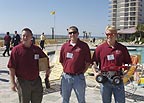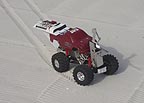November 21, 2007
Students meet challenges of initial robotics contest

Caption follows story
The students, who are part of the first group selected for a special engineering leadership program at SIUC, participated in the National Association for Industrial Technology annual robotics competition, held this year in Panama City, Fla. It was the first time an SIUC chapter of NAIT participated in the competition said Bruce DeRuntz, associate professor of technology in the College of Engineering at SIUC.
As one of about a dozen teams competing, the SIUC team placed ninth — a good showing considering the fact that the local NAIT student chapter started this fall. Other colleges and universities that participated included the University of Northern Iowa, Missouri State University, Eastern Kentucky University, Morehead State University, University of Wisconsin-Platteville, University of North Dakota, Central Connecticut State University, Cal Poly, Iowa State University and Millersville University, and Spoon River College.
The students started the chapter as a part of their leadership requirements as recipients of The Blaudow — ATS Program for Technical Leadership in Manufacturing scholarship program.
Richard W. Blaudow, who founded Advanced Technical Services Inc., and his wife, Brigitte, donated the money to make the program possible. The first recipients of the award started this fall at SIUC, where each is pursuing an engineering degree.
"The Blaudow/ATS program requires students to take an active leadership role, so I kind of had a captive audience for starting the chapter," DeRuntz said. "They asked what they had to do, and I told them, 'you have to build a robot.'"
DeRuntz said the four students who started the NAIT chapter worked hard to get the effort moving.
"These students are really exceptional, the cream of the crop," said DeRuntz, who helped advise the students as they started the NAIT chapter and prepared for the competition.
Building the robot, however, was only part of the challenge. The students also had to scramble to find funding for the hardware and travel expenses. Caterpillar Inc. kicked in a tidy sum, as did ATS and the engineering college. Hot dog sales by the students also played a role in raising the approximately $2,000 needed for the effort.
"This was really a huge undertaking, to design and build a working robot and secure funding in 40 days," DeRuntz said.
The competition varies each year, with the following year's objective and course typically announced a year in advance, DeRuntz said. While the objective usually involves some sort of obstacle course in a hotel lobby and simple task, DeRuntz said this year's objective involved some hide-and-seek with the famous beaches of Panama City, known by most college students as a prime spring break location.
Organizers instructed teams to build a robot that could traverse the sand in search of a magnet, that they had buried 4 inches deep somewhere within a 24-square-foot area. It was up to each team to come up with a design that could not only maneuver in and detect a magnetic field, but plant a small pylon at the point closest to the actual magnet.
The various teams entered an array of designs, from tracked vehicles to tractor-like designs. Some used standard metal detector technology mounted on their vehicles to find the magnet while others deployed specialized transistors or sensor arrays that their vehicles dragged along in the sand. A few used a series of magnetic compasses.
"There were some of the most sophisticated designs you've ever seen," DeRuntz said.
Some worked well, others not so well. DeRuntz recalled a couple of tracked vehicles bogged down almost immediately in the sandy conditions, despite their elaborate designs. Others actually buried themselves in the sand as they struggled to move.
"We found simpler is better," DeRuntz said. "We did not get stuck. But we had a hard time finding the magnet."
The judges scored the teams on criteria such as design, innovation and craftsmanship, as well as their ability to find and mark the magnet's position.
Three students from SIUC — Jerry Teel, an industrial technology major from Milledgeville; Tyler Madding, an industrial technology major from Decatur; and Max Kleiboeker, an electrical engineering technology major from Mount Vernon, all made the trip to Panama City for the competition, which took place Oct. 26.
The SIUC team settled on a miniature "monster truck" motif, with large tires to handle the sand and specialized transistors to detect the magnet. It also carried a robotic arm out front that could place the marker into the sand once it located the magnet.
With the chapter up and running, DeRuntz said the team is looking forward to next year's competition in Nashville, Tenn. He's also hoping more engineering students join the fledgling NAIT chapter.
"We have so many great student project teams here in the College of Engineering — concrete canoe, formula race car, hovercraft on and on. Our students like to apply the knowledge they're learning in our programs, they like to be on a team and have the opportunity to lead," DeRuntz said. "This is really going to open up a lot of doors for our programs."

Caption follows story
Caption:
Robot builders — Southern Illinois University Carbondale engineering students (from left) Jerry Teel, Tyler Madding and Max Kleiboeker get ready to compete with their robot recently during the National Association of Industrial Technology's annual robot competition, held this year in Panama City, Fla. The three students represented a new student chapter of NAIT formed this fall at SIUC as part of an engineering leadership program.
Madding is an industrial technology major from Decatur. Kleiboeker is an electrical engineering technology major from Mount Vernon. Teel is an industrial technology major from Milledgeville.
Photo provided
Magnet finder — A robot built by Southern Illinois University Carbondale engineering students competes during the National Association of Industrial Technology's annual robot competition, held this year in Panama City, Fla. This year's task involved finding a magnet buried in the sand on the beach.
Photo provided
